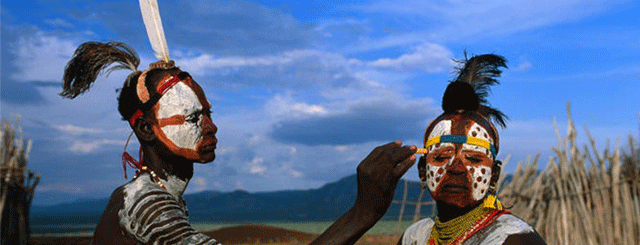Omo Valley
Duration: Twelve days Book Now! Day 1: Depart Europe/USA/China etc on Ethiopian Airlines Day 2: Arrive, transfer to hotel of your choice. After lunch city tour. Day 3: Drive to…
Duration: Twelve days Book Now! Day 1: Depart Europe/USA/China etc on Ethiopian Airlines Day 2: Arrive, transfer to hotel of your choice. After lunch city tour. Day 3: Drive to…

Visitors with an interest in observing pre-materialist cultures and in anthropology will find much to fascinate them in the different ethnic groups situated along the Omo River, with marvellous scenery, wild life and bird life as an added bonus. Before reaching the Omo, just before Arba Minch, a visit can be made to Chencha, the home of the Dorze people, famed for their bamboo bee-hive shaped houses and their weaving skills. Further south are the Konso, noted for their intricately terraced hillsides and the wooden totems with which they adorn their cemeteries. Along the Omo River a variety of different ethnic groups are found, such as the Arbore, Bume, Galeb, Karo, Hamer and Mursi, whose contact with the modern world has come only within the last two to three decades. (The Omo, flowing for nearly 1000 km from the highlands south west of Addis Ababa to Lake Turkana in Kenya, provides excellent opportunities for white water rafting.) For a trip to the Omo Valley at least 8 days should be allowed. On the east bank, the construction of lodges has obviated the need for camping, but on the west bank it is still necessary. Ethiopian Quadrants can provide well fitted mobile camps, with cooks, full board, generators, freezers, cold drinks and toilet and shower tents.
Ethiopian Quandrants is now promoting a new circuit in the west of Ethiopia, in Beni Shangul Gumuz Region, west of Lake Tana to the border with Sudan.
Here visitors can see the colorful markets of the Agaw, Gumuz, Berta, Mao, Komo, and Ganzo ethnic groups, and the traditional gold mining techniques of the Berta community. They dig a hole up to 7-8 meters deep, and then take the soil to a nearby river where it is sifted in the search for gold.
This routing, in addition to the unique and diversified cultures found there, has beautiful and stunning landscapes. It follows the Blue Nile River and its major tributaries.
On its completion in 2025, the Grand Ethiopian Renaissance Dam (GERD) with its massive reservoir will be one of the major tourist sites in the country in general, and the region in particular.
Return to Addis Ababa can be as a loop through the forested highlands of Wollega, with abundant forest coffee, or by air from Assosa – the capital of the Region.
Or we can continue to the far west, to Gambella, where along the Baro River are found the Anuak, Nuer and Misinger people.Return from Gambela to Addis Ababa can be by air, or by a 2 day road journey.
In the far west in Gambella, along the Baro river can be found the Anuak, Nuer and Misingir people. Gambella can be reached by air, or by a 2 day road trip.
Nearer Addis Ababa, from the Awash Park eastwards, are the Afar, most of whom are still pastoralists and who can pack up and carry their houses on the backs of camels.
© 2025 Ethiopian Quadrants . All rights reserved.